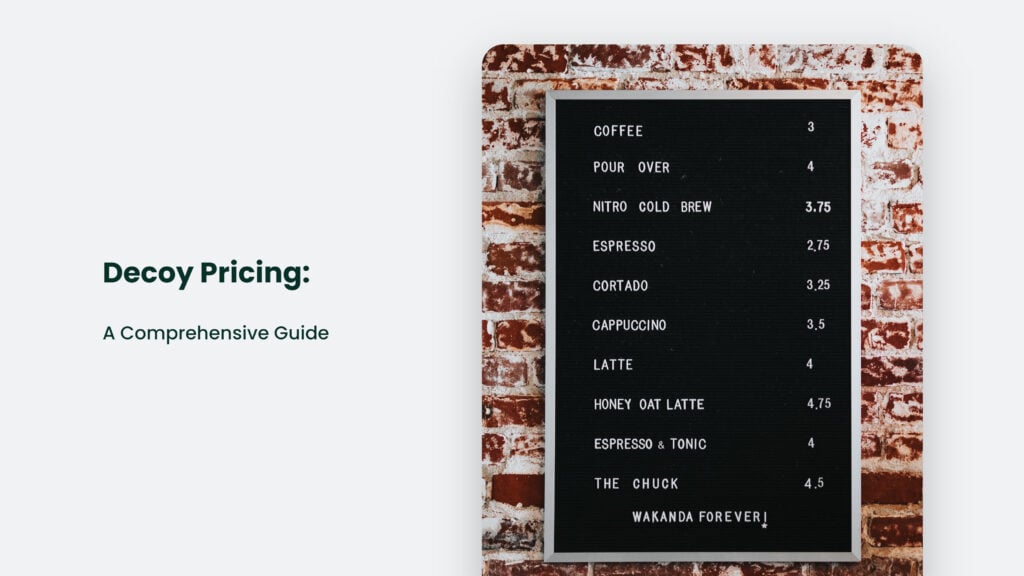

Decoy Pricing: A Secret Weapon of Business

As Seen On
Have you ever gone to a restaurant and felt utterly overwhelmed by the menu? You’ve encountered options priced significantly higher or lower than the other menu items. It is where the concept of “decoy pricing” comes in.
Decoy pricing is a marketing technique where businesses offer additional options to influence customers’ choices. By including a decoy item, businesses can make their desired option seem more attractive and increase the likelihood of a customer choosing it.

It is the power of decoy pricing in action. Think of it this way: you’re at a restaurant trying to decide between a burger and a salad. The burger is priced at $12, and the salad is priced at $10. However, the menu also includes a more expensive steak for $20. Suddenly, the burger seems like a much better value for money, doesn’t it?
Let’s dive deeper into this fascinating technique and explore how it can benefit your business.
The Science of Decoy Pricing:
Decoy pricing is based on the concept of “anchoring.” Anchoring refers to the psychological phenomenon in which the first piece of information a person receives influences subsequent decisions. In the case of decoy pricing, the decoy item acts as an anchor, making the desired option seem more appealing.
This technique is rooted in behavioural economics and has been studied extensively by psychologists and economists. Daniel Kahneman and Amos Tversky conducted one of the most famous studies in this field. Their study found that when people were offered a choice between two options, they were likelier to choose the option that was priced higher, even if the cheaper option was a better value for money.
How to Use Decoy Pricing in Your Business:
Decoy pricing can be used in various industries, including restaurants, retail, and online businesses. The key to using decoy pricing effectively is to ensure that the decoy option is compelling enough to influence the customer’s decision but not so appealing that they choose it instead of the desired option.
Here are some tips to help you get started with decoy pricing in your business:
- Determine your desired option: The first step in decoy pricing is determining the option you want to sell. It could be your most profitable item or an item you’re trying to push more of.
- Create a decoy option: Once you’ve determined your desired option, you must create one. Depending on the desired outcome, this option should be priced higher or lower than the desired option. The decoy option should be priced higher to make the preferred option seem more appealing. If you want to make the desired option seem like a better value for money, the decoy option should be priced lower.
- Test and refine: Once you’ve created your decoy option, it’s essential to test it out to see if it’s working. If the decoy option does not have the desired effect, refine it until it does.
- Use visuals: Visuals help make the decoy option more appealing and easier to understand. It could be in images, diagrams, or even videos.
- Make it relevant: The decoy option should be appropriate to the customer. For example, if you’re selling a new product, the decoy option could be a similar product from a competitor.
- Be transparent: It’s important to be transparent about the decoy option and explain why it’s there. It will help build trust with your customers and ensure that they understand the purpose of the decoy.
- Evaluate and adjust: Regularly evaluate the effectiveness of your decoy pricing and make adjustments as needed. The market and customer preferences can change over time, so monitoring how the decoy option performs and making changes as needed is essential.
The Power of Decoy Pricing:
Decoy pricing can have a significant impact on your business. It can help you increase sales and profits while making your customers feel like they’re getting a good deal. Here are some of the benefits of using decoy pricing:
- Increased sales: By making your desired option seem more appealing, you can increase the likelihood of a customer choosing it. It can result in increased sales and higher profits.
- Better value for money: By including a decoy option priced lower or higher than the desired option, you can make the option seem better. It can help you attract price-sensitive customers looking for a good deal.
- Increased customer satisfaction: When customers feel like they’re getting a good deal, they’re more likely to be satisfied with their purchase. It can lead to increased customer loyalty and repeat business.
- Competitive advantage: Using decoy pricing, you can differentiate yourself from your competitors and stand out in the market. It can attract new customers and retain existing ones.
- Improved brand image: Using decoy pricing effectively can enhance your brand image and reputation. Customers will associate your business with offering good value for money, which can help increase brand awareness and loyalty.
Famous Examples of Decoy Pricing:

Decoy pricing is used by many businesses, both big and small. Here are some famous examples of decoy pricing in action:
The Economist:
The Economist is a weekly news and international affairs magazine. They offer three subscription options: digital only, print only, and print and digital. The print and digital option is priced higher than the other two options, making it seem like a better value for money. It has helped The Economist increase its subscriber base and profits.
Apple:
Apple is well known for using decoy pricing in its product lineup. For example, when the iPhone was first released, there were two options: the 4GB model and the 8GB model. The 8GB model was priced higher, making it seem like a better value for money, even though most people didn’t need the extra storage. It helped Apple increase its sales and profits.
Netflix:
Netflix uses decoy pricing in its subscription options. They offer three options: basic, standard, and premium. The standard option is priced higher than the basic option but lower than the premium option. It makes the standard option seem like the best value for money and has helped Netflix increase its subscriber base.
Frequently Asked Questions:
What are the benefits of decoy pricing?
The benefits of decoy pricing include increased sales, better value for money, increased customer satisfaction, a competitive advantage, and an improved brand image. By using decoy pricing, businesses can differentiate themselves from their competitors, increase their profits, and make their customers feel like they’re getting a good deal.
The Bottom Line:
In conclusion, decoy pricing is a powerful marketing technique that can help businesses increase sales and profits while making their customers feel like they’re getting a good deal. Using decoy pricing effectively, businesses can differentiate themselves from their competitors, improve their brand image, and build customer loyalty. So, the next time you’re feeling overwhelmed by a menu, think about the power of decoy pricing and how it might affect your choices.
Konger
Up until working with Casey, we had only had poor to mediocre experiences outsourcing work to agencies. Casey & the team at CJ&CO are the exception to the rule.
Communication was beyond great, his understanding of our vision was phenomenal, and instead of needing babysitting like the other agencies we worked with, he was not only completely dependable but also gave us sound suggestions on how to get better results, at the risk of us not needing him for the initial job we requested (absolute gem).
This has truly been the first time we worked with someone outside of our business that quickly grasped our vision, and that I could completely forget about and would still deliver above expectations.
I honestly can't wait to work in many more projects together!
Disclaimer
*The information this blog provides is for general informational purposes only and is not intended as financial or professional advice. The information may not reflect current developments and may be changed or updated without notice. Any opinions expressed on this blog are the author’s own and do not necessarily reflect the views of the author’s employer or any other organization. You should not act or rely on any information contained in this blog without first seeking the advice of a professional. No representation or warranty, express or implied, is made as to the accuracy or completeness of the information contained in this blog. The author and affiliated parties assume no liability for any errors or omissions.

